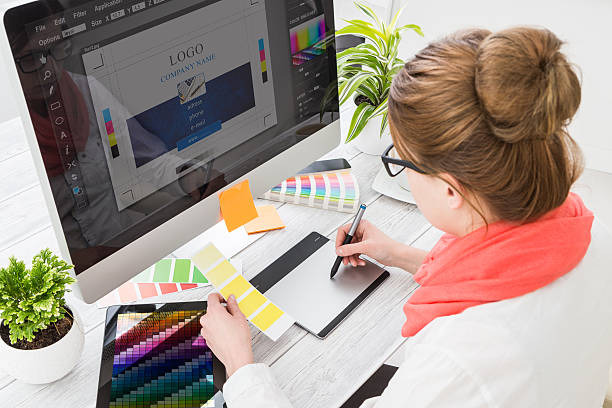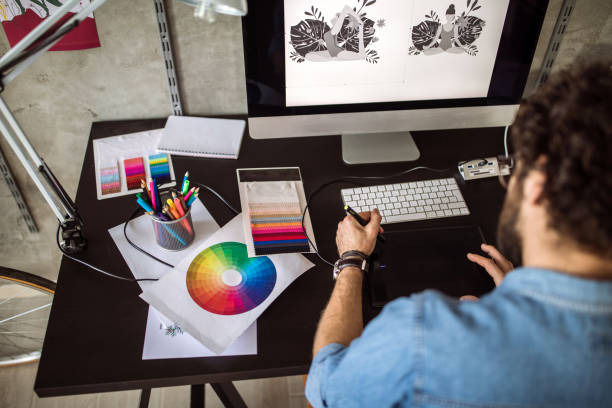Graphic design is an important marketing tool, so a graphic designer always has various career opportunities in many different fields.
If you are interested in learning to be a graphic designer, it is essential to understand what a graphic designer is and the requirements you need to meet to pursue this profession.
Job Description
What Is Graphic Design?
Graphic design refers to a craft where professionals make visual content to communicate messages.
By using visual hierarchy and layout techniques, these designers use pictures and typography to meet customers’ specific needs and focus on the logic of displaying elements in interactive designs, to optimize customers’ experience.
Duties and Responsibilities
Graphic designers normally make visual concepts by hand or use computer software to communicate their ideas that inform, inspire, and captivate consumers. They may use design elements to get decorative or artistic effects.
Graphic design is essential to selling and marketing products and is a vital component of logos and brochures.
As a result, graphic designers, sometimes called communication designers or graphic artists, often work with people in promotions and advertising, marketing, and public relations.

Following are the primary duties and responsibilities of a graphic designer:
- Meet with the art director or clients to define the scope of a project.
- To make designs, use photo editing software, digital illustration, and layout software.
- Produce visual elements that deliver the desired message, such as original images, logos, and illustrations.
- Present design concepts to art directors and clients.
- Review designs for errors before printing and publishing them.
- Design layouts and pick images, colors, and typefaces to utilize.
- Incorporate changes recommended by art directors and clients into the final design.
Where Do Graphic Designers Work?
Graphic designers carry approximately 265,000 jobs, and the biggest employers of the graphic designer are as follows:
| Employers | Percent |
|---|---|
| Self-employed worker | 21 |
| Specialized design service | 12 |
| Public relations, advertising, and related service | 9 |
| Printing and related support activities | 7 |
| Periodical, book, newspaper, and directory publisher | 6 |
Graphic designers normally work in studios, where they can access computers, drafting tables, and the software essential to making their designs.
Graphic designers can work independently, but people who work for specialized graphic design firms usually work with one design team.
Education Requirements

Getting an associate’s degree or certificate in graphic design might qualify graduates for technical support or assistant positions in the field.
But in most cases, you will need at least a bachelor’s degree from an accredited college, university, or private design school to apply for design positions.
A bachelor’s degree in graphic design or one related area is typically required.
But people with a bachelor’s degree in other fields may pursue technical training in the graphic design field to meet hiring qualifications.
Essential Skills

Technical Skills
The following are some of the desirable technical skills for graphic designers:
1. Picture skills (photography) Or photo editing
You may be responsible for integrating photos into a graphic design project. Hence, it is essential to know how to fine-tune stock photos or take high-quality images.
2. Digital technology (HTML, CSS, JS)
These technology skills will be handy if you want to design webs or work as one visual designer.
3. UX design
As a skilled graphic designer, you must understand how to make simple designs that are useful and serve well for established accessibility guidelines.
4. RGB and CMYK
You must be able to pick the proper color set for your projects.
CMYK will be great for print projects, whereas RGB is commonly utilized for digital designs.
5. Design principles
Successful graphic designers should know how to use white space, hierarchy, color, and other principles to produce well-balanced designs.
6. Follow The Branding Guideline
Branding guidelines are standards that help identify how one brand will be presented to audience members. So to succeed in your industry, following those guidelines closely is necessary.
7. Font selection
Font size, weight, and type will affect your designs’ appearance and may impact how others perceive your message. Hence, you must be able to pick a proper font for your project.
8. Typography skills
As one graphic designer, you should be able to arrange letters and words in a seemingly attractive way.
Soft Skills
No matter how good your technical skills are, becoming a successful designer in this field will be complex if you do not have the necessary soft skills.
1. Storytelling
If you want to appeal to others, storytelling skill is a great way. It will allow you to understand what customers need and show them how you can help. This skill will benefit a visual designer charged with developing consistent brand images.
2. Creativity
It involves the ability to make new ideas and utilize them to handle issues or communicate with others. A successful graphic designer is highly innovative and creative.
3. Time management
Graphic designing is one of the common deadline-driven professions. So managing your time effectively is necessary to succeed in this field.
4. Communication skills
As a graphic designer, you must communicate effectively with your clients, colleagues, and other stakeholders.
Potential employers favor graphic designers with solid communication skills, allowing them to express their ideas consistently and clearly.
5. Emotional intelligence
Graphic designers with high levels of emotional intelligence excel at managing emotions, allowing them to deal with conflict and effectively reduce stress on team members.
6. Collaboration skills
Decent collaboration skills make working with others to achieve a common goal effortlessly. A skilled graphic designer can listen to other members, communicate consistently, and own up to mistakes.
Essential Tools

The following are hardware, software, and essential equipment for a graphic designer. With them, this professional’s work will be taken to the next level.
Essential Hardware
- Laptop.
- Desktop computer.
- A Reliable hard drive.
- Top-end smartphone.
- Graphics tablet and stylus.
- A high-res monitor.
- Studio camera.
Essential Software
- Antivirus software.
- Creative software.
- VPN software.
- Productivity software.
Creative Gear
- Pantone swatch book
- Quality sketchbook or notebook
Home Office
- Variable desk
- Ergonomic chair
Job Outlook

Technological advancements have introduced new kinds of graphic design, so the birth of new graphic design jobs is inevitable. It has changed the whole context of careers in the field.
The demand for a “traditional” graphic designer who typically works for print publishers has fallen dramatically, but it does not tell the entire story.
The Bureau of Labor Statistics predicts that the demand for graphic designers in computer systems design services will grow by 24% through 2028.
Much of that demand is produced by businesses’ increased need for imagery and digital graphics because they want to improve their digital presence.
Here are the common titles related to graphic designers:
- Art director
- Web designer
- Creative director
- Graphic designer
- UX (User experience) designer
Once you have been equipped with the proper training and knowledge, there are many design job options available out there ready to welcome you.
Salary
The average annual salary of a graphic designer is $100,172. The range for most popular graphic designer positions typically falls between $35,666 and $106,039.
Remember that salary ranges might vary widely depending on many factors, such as education, certifications, position, additional skills, and experience.
Advantages and Disadvantages
Here are some pros and cons that any graphic designer can deal with.
Pros
- You can leverage various digital channels.
- It is possible to avoid heavy physical work.
- Good job prospects for graphic designers.
- The graphic designer can be creative at work.
- A graphic designer can make good money.
- You can come home from work rather early.
- A graphic designer can work self-employed.
- You can work indoors as one graphic designer.
- You can work for various companies and organizations.
- Good life-work balance for a graphic designer.
- You can stay up-to-date with the newest technologies.
Cons
- Most graphic designers do not get rich
- You might just work with your computer all day long
- Lots of graphic design positions will be outsourced in the future
- A degree is required to work as one graphic designer
- Many graphic experts are struggling to pay back student loan debt
- You may be dependent on the parents for a long time
- Rather limited promotion options
- You can get lazy in the long term
- You may sometimes feel lonely at work
- You will typically not see the result quickly
FAQs
How Many Types of Graphic Design Are There?
Graphic design includes various specializations and fields, ranging from web and print design to motion and animation graphics. The graphic design delivers options and opportunities for individuals of almost any interest.
About thirty years ago, graphic design focused on print-related things like movie posters, magazines, and advertisements. Now we live in the digital age, which led to the birth of some new types of graphic design.
Some of the modern-day graphic design examples originate from technological advancements. Here is a glimpse of some of these kinds of graphic design:
Motion or Animation Graphics Design
It brings visual elements to life via special effects, video games, movies, and TV shows.
User Experience (UX) Design
It refers to ensuring an application and website are satisfying and easy to use. Those designers will emphasize usability, value, desirability, and adaptability.
Website Design
It involves making intuitive and engaging web pages for customers. It includes the overall layout, color scheme, and navigation.
Is Graphic Design a Good Career?
Graphic design is an excellent job for people who want to put their creativity to work while getting essential software skills. This career has been around for thousands of years, evolving with society’s needs.
How to Become a Graphic Designer?
While the path to pursuing a career can vary from person to person, here are the key steps you should be aware of. For details, check out this article.
- Step 1: Learn the Principles
- Step 2: Pick a Course
- Step 3: Learn Graphic Design Tools
- Step 4: Design Projects
- Step 5: Build a Portfolio
- Step 6: Sell Yourself
Is Graphic Design One Dying Career?
No. In contrast, it is one of the most in-demand careers today. Organizations and companies are always coveting talented graphic designers.
Are There Free Courses for Graphic Design?
The answer is Yes! There are various free courses online, specifically made for graphic design. You can easily find them by searching online.
Career Advice
Graphic design is an excellent career for those who are creative thinkers and love technology, art, and communication.
There are design demands across all industries, so a graphic designer has various opportunities to take on a range of exciting projects.
It can also be one very fulfilling career, as a graphic designer can see the real-world impact of his work.
To start your career in this field, you need to start by getting a bachelor’s degree in graphic design or one related field. Then, consider getting a certificate, which will give you an edge when applying for a job.
Also, don’t forget to strengthen your skills, both hard and soft, to succeed as a graphic designer. Hopefully, the information in my article has provided you with useful content. Thank you for your interest in the article!
